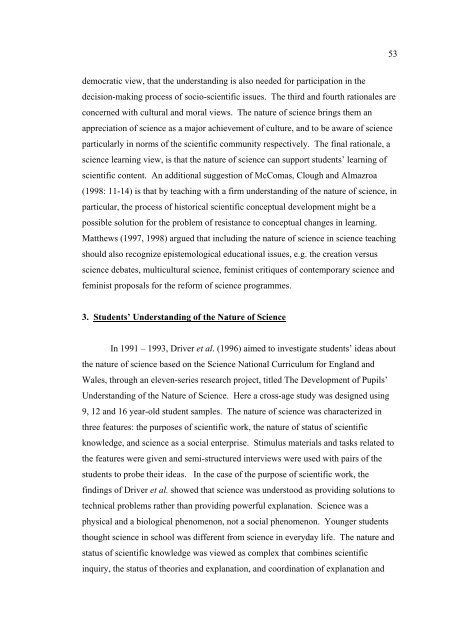an innovative approach
an innovative approach
an innovative approach
Create successful ePaper yourself
Turn your PDF publications into a flip-book with our unique Google optimized e-Paper software.
democratic view, that the underst<strong>an</strong>ding is also needed for participation in the<br />
decision-making process of socio-scientific issues. The third <strong>an</strong>d fourth rationales are<br />
concerned with cultural <strong>an</strong>d moral views. The nature of science brings them <strong>an</strong><br />
appreciation of science as a major achievement of culture, <strong>an</strong>d to be aware of science<br />
particularly in norms of the scientific community respectively. The final rationale, a<br />
science learning view, is that the nature of science c<strong>an</strong> support students’ learning of<br />
scientific content. An additional suggestion of McComas, Clough <strong>an</strong>d Almazroa<br />
(1998: 11-14) is that by teaching with a firm underst<strong>an</strong>ding of the nature of science, in<br />
particular, the process of historical scientific conceptual development might be a<br />
possible solution for the problem of resist<strong>an</strong>ce to conceptual ch<strong>an</strong>ges in learning.<br />
Matthews (1997, 1998) argued that including the nature of science in science teaching<br />
should also recognize epistemological educational issues, e.g. the creation versus<br />
science debates, multicultural science, feminist critiques of contemporary science <strong>an</strong>d<br />
feminist proposals for the reform of science programmes.<br />
3. Students’ Underst<strong>an</strong>ding of the Nature of Science<br />
In 1991 – 1993, Driver et al. (1996) aimed to investigate students’ ideas about<br />
the nature of science based on the Science National Curriculum for Engl<strong>an</strong>d <strong>an</strong>d<br />
Wales, through <strong>an</strong> eleven-series research project, titled The Development of Pupils’<br />
Underst<strong>an</strong>ding of the Nature of Science. Here a cross-age study was designed using<br />
9, 12 <strong>an</strong>d 16 year-old student samples. The nature of science was characterized in<br />
three features: the purposes of scientific work, the nature of status of scientific<br />
knowledge, <strong>an</strong>d science as a social enterprise. Stimulus materials <strong>an</strong>d tasks related to<br />
the features were given <strong>an</strong>d semi-structured interviews were used with pairs of the<br />
students to probe their ideas. In the case of the purpose of scientific work, the<br />
findings of Driver et al. showed that science was understood as providing solutions to<br />
technical problems rather th<strong>an</strong> providing powerful expl<strong>an</strong>ation. Science was a<br />
physical <strong>an</strong>d a biological phenomenon, not a social phenomenon. Younger students<br />
thought science in school was different from science in everyday life. The nature <strong>an</strong>d<br />
status of scientific knowledge was viewed as complex that combines scientific<br />
inquiry, the status of theories <strong>an</strong>d expl<strong>an</strong>ation, <strong>an</strong>d coordination of expl<strong>an</strong>ation <strong>an</strong>d<br />
53
















